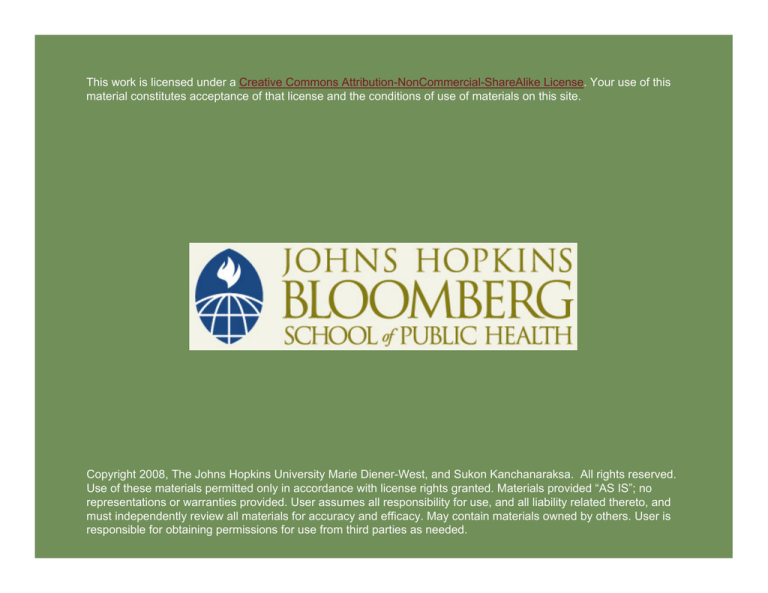
This work is licensed under a Creative Commons Attribution-NonCommercial-ShareAlike License. Your use of this
material constitutes acceptance of that license and the conditions of use of materials on this site.
Copyright 2008, The Johns Hopkins University Marie Diener-West, and Sukon Kanchanaraksa. All rights reserved.
Use of these materials permitted only in accordance with license rights granted. Materials provided “AS IS”; no
representations or warranties provided. User assumes all responsibility for use, and all liability related thereto, and
must independently review all materials for accuracy and efficacy. May contain materials owned by others. User is
responsible for obtaining permissions for use from third parties as needed.
Measures of Prognosis
Sukon Kanchanaraksa, PhD
Johns Hopkins University
Quantifying the Prognosis
A person who was just diagnosed with a disease would be
interested in the prognosis of the disease
Prognosis is predicting the progress or outcome of the
disease
Any measures used to quantify prognosis must then be casebased
− That is, the denominator is the number of people with the
specified disease
3
Natural History of Disease
Preclinical
Clinical
Disease
onset
Diagnosis Prognosis
Preclinical
Clinical
Disease
Prognosis
onset
Diagnosis
4
Identifying the Onset of Disease
Infectious diseases
− Exposure (bite, infection, etc.)
− Biological culture
− Presence of antibody responses, viral DNA and RNA
5
Identifying the Onset of Disease
Cancer
− Initial damage from radiation or chemicals
− First cancer cell division
− Lost of cell replication
− Screening for pathologic changes during preclinical
phase
− First evidence of signs and symptoms
− Medical diagnosis of disease
Preclinical phase
Biological
onset of
disease
Pathologic
evidence
of disease
Clinical phase
Signs and
symptoms
of disease
Medical
care
sought
Diagnosis
Treatment
6
Identifying the Endpoints of Disease
Death
Cure
Remission
− A decrease in, or disappearance of, signs and symptoms
of disease
Recurrences
− A return of disease
7
Expressing Prognosis
Case-fatality (rate) or CFR
Five-year survival
Observed survival rate
Median survival time
Relative survival rate
8
Expressing Prognosis: Case-Fatality Rate (CFR)
Case-fatality (rate) =
number of people who die of a disease
number of people who have the disease
Example
− 200 people with the disease
− 20 deaths from the disease
− CFR = 20 x 100
200
− 10%
9
Expressing Prognosis: Five-Year Survival
Five-year survival is the proportion of patients who are alive
five years after diagnosis
number of persons with the specified disease surviving 5 years
totalnumber of persons with the specified disease
Preclinical
Clinical
Disease
onset
Diagnosis Prognosis = alive 5 years
10
Example: Five-Year Survival
The five-year survival rate for women with localized (stage I)
breast cancer
− 1940s: 78%
− Now: 97%
http://www.cancer.org/eprise/main/docroot/CRI/content/CRI_2_4_1X_What_are_the_
key_statistics_for_male_breast_cancer_28
11
Interpreting Five-Year Survival
Increased five-year survival for cancer patients over time is
generally inferred to mean that cancer treatment has
improved and that fewer patients die of cancer
Increased five-year survival, however, may also reflect
diagnosing early-stage cancer and/or finding people who
would never have become symptomatic from their cancer
http://www.cancer.org/eprise/main/docroot/CRI/content/CRI_2_4_1X_What_are_the_key_statistics
_for_male_breast_cancer_28
12
Surviving Five Years?
1990
1996
2000
Death
Preclinical
Clinical
Disease
onset
Diagnosis Prognosis
Did this patient survive five years?
13
Five-Year Survival in Screened Population
1990
1994
Preclinical
Clinical
Disease
onset
Diagnosis Prognosis
Detected by Screening
2000
Death
Did this patient survive five years?
14
Problem of Five-Year Survival in Screened Population
1990
Diagnosis
1996
2000
Death
Disease
onset
1990
Prognosis
Lead time
1994
2000
Death
Disease
onset
Diagnosis Prognosis
detected by screening
If early detection is ineffective in preventing death,
15
Lead Time
Lead time is the time between the early detection of disease
(e.g., by screening) and the time of it usual clinical diagnosis
Lead time bias occurs because of the failure to account for
the lead time when calculating survival
Some cancer screening programs were thought to improve
survival until lead time bias was addressed
16
Issues of Five-Year Survival
The measure requires five years of follow-up to know that a
person survives five years
Survival may reflect changes in diagnosis or treatment over
time
− The measure is better used in an epidemiologic study,
such as a clinical trial (when prognosis of subjects with
different treatments are compared in similar time period
over time) rather than an evaluation of a cancer prognosis
over time (without comparison)
Source: http://jama.ama-assn.org/cgi/content/full/283/22/2975
(JAMA 2000: 283: 2975–2978)
17
Survival Proportion and Survival Rate
Example: a study of 10 patients
− 4 died at the end of the five-year study period
Case fatality (rate) is 4/10=40%
Survival proportion is 6/10=60%
This value does not consider the varying length of time that
each patient was followed (alive)
Survival (rate) accounts for the varying length of follow-up
− It is really a proportion, but it is often called a rate
18
Expressing Prognosis: Observed Survival Rate
The observed survival (rate) is an estimate of the probability
of surviving
(Cumulative) probability of surviving can be calculated using
the technique of life table or Kaplan-Meier
Survival curve plots percent survival (cumulative probability
of survival) by time (time since the beginning of study)
19
Male Survival by Race or Ethnicity, SEER (1988–1997)
All cancers
Lung cancer
Colorectal cancer
Prostate cancer
Source: http://surveillance.cancer.gov/statistics/types/survival_by_race.pdf
20
Expressing Prognosis: Median Survival Time
Median survival time is the length of time that half of the
study population survives
21
Median Survival Time
Percent surviving
100%
75%
50%
25%
0%
0
1
2
3
4
5
Years of follow-up
22
Comparison of Two Survival Curves
Series 1
Series 2
100%
90%
Percent surviving
80%
Series 2
70%
60%
50%
Series 1
40%
30%
20%
10%
0%
0
1
2
Years in study
3
4
5
23
Issues with Observed Survival
Deaths from diseases other than the disease of interest are
not excluded from the calculation of observed survival
As the result, observed survival value will be underestimated
(lower)
Need to adjust the observed survival by removing the effect
of other causes
24
Expressing Prognosis: Relative Survival Rate
Relative survival rate is the ratio of the observed survival
(rate) to the expected survival (rate)
It compares survival in the study group (e.g., cancer) to the
survival of a comparable group without the disease of interest
It removes from the observed survival the effect of deaths
from all other causes
Comparison group could be persons in the general
population similar to the patient group with respect to age,
sex, race, and calendar year of observation, and free of
disease of interest, such as free of cancer
Its value can be above 100%
− Suggesting that observed survival is better than the
survival expected from the general population
Source: http://www.cdc.gov/nchs/datawh/nchsdefs/relsurvrate.htm
25
Observed vs. Relative Survival Rates: Cancer, All Sites
100%
Expected
Survival Rate
Relative
Observed
0%
0
1
2
3
4
5
6
7
8
9
10
Years after Diagnosis
26
Survival Rates by Age for Patients with Colon Cancer
SEER 1981–1987
Age at Diagnosis
Five-Year Survival Rate
Observed
Relative
45–54
57.1
59.2
55–64
53.6
58.5
65–74
47.8
57.8
75+
31.7
54.1
27
Review
List measures of prognosis
What is the problem with the use of observed survival?
Are the following measures a rate, a ratio, or a proportion?
− Case fatality
− Five-year survival
− Observed survival
− Relative survival
28









